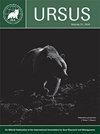采收政策改变后的美国黑熊人口统计数据
IF 0.8
4区 生物学
Q4 ZOOLOGY
引用次数: 3
摘要
摘要:采收会影响野生动物种群的大小和组成。美国黑熊(Ursus americanus)在美国阿肯色州中部内陆高地的种群,由于收成和栖息地的变化几乎灭绝,但自20世纪50年代末和60年代初重新引入以来,在地理上和人口上都有所扩大。自2001年允许在私人土地上使用诱饵以来,收获水平有所提高;因此,我们对2个黑熊种群进行了人口统计分析,以评估这一政策变化的影响。在阿肯色州的瓦希塔(2006-2008年)和奥扎克(2009-2011年)国家森林中,我们评估了针对诱饵的收获组成,并使用非侵入性基因采样结合捕获-再捕获方法来估计黑熊种群的密度、存活率和种群增长率(λ)。使用饵料捕获的雄鱼多于雌鱼。捕获概率逐年变化;因此,多年的数据对于捕获准确的种群参数是有价值的。瓦希塔的熊密度约为14只/100平方公里,欧扎克的熊密度约为26只/100平方公里,这比历史数据(1989-1990年)的估计要大。因此,在允许在私人土地上使用诱饵的情况下,这些种群保持或超过了以前的密度估计。然而,与任何收获种群一样,重要的是继续监测种群,以便能够就今后适当的收获政策做出决定。本文章由计算机程序翻译,如有差异,请以英文原文为准。
Demographics of American black bear populations following changes in harvest policy
Abstract: Harvest can affect the size and composition of wildlife populations. American black bear (Ursus americanus) populations in the Central Interior Highlands, Arkansas, USA, were nearly extirpated as a result of harvest and habitat change, but have expanded geographically and demographically since reintroduction in the late 1950s and early 1960s. Harvest levels have increased since baiting was permitted on private land in 2001; therefore, we initiated demographic analyses of 2 black bear populations to evaluate the effect of this policy change. We evaluated composition of harvest in response to baiting and used noninvasive genetic sampling in conjunction with capture–recapture methods to estimate density, survival, and population growth rate (λ) of black bear populations at locations within the Ouachita (2006–2008) and Ozark (2009–2011) national forests, Arkansas. More males were harvested than females with the use of bait. Capture probability varied annually; thus, multi-year data were valuable for capturing accurate population parameters. Density was approximately 14 bears/100 km2 in the Ouachitas and approximately 26/100 km2 for the Ozarks, which was greater than estimates from historical data (1989–1990). Thus, these populations maintained or exceeded previous density estimates while the use of bait was allowed on private land. However, as with any harvested population, it will be important to continue to monitor the population to be able make decisions about appropriate harvest policies going forward.
求助全文
通过发布文献求助,成功后即可免费获取论文全文。
去求助
来源期刊

Ursus
生物-动物学
CiteScore
2.00
自引率
15.40%
发文量
12
审稿时长
>12 weeks
期刊介绍:
Ursus includes a variety of articles on all aspects of bear management and research worldwide. Original manuscripts are welcome. In addition to manuscripts reporting original research, submissions may be based on thoughtful review and synthesis of previously-reported information, innovative philosophies and opinions, and public policy or legal aspects of wildlife conservation. Notes of general interest are also welcome. Invited manuscripts will be clearly identified, but will still be subject to peer review. All manuscripts must be in English. All manuscripts are peer-reviewed, and subject to rigorous editorial standards.
 求助内容:
求助内容: 应助结果提醒方式:
应助结果提醒方式:


